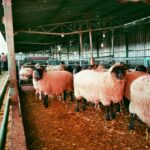Starting a small farm can be an exciting and rewarding venture, but it requires careful planning, dedication, and hard work. Whether you’re looking to grow crops, raise livestock, or engage in sustainable agriculture, having a well-thought-out plan is crucial for success. Here’s a step-by-step guide to help you get started on your small farm journey.
Step 1: Define Your Goals and Farm Type
Before diving into farming, it’s essential to define your goals and decide what kind of farm you want to start. Your farm type will influence everything from the crops you plant to the animals you raise and how you manage the farm.
- What do you want to farm? Decide if you want to grow crops, raise livestock, or perhaps both. Consider factors like market demand, personal interest, and available resources.
- What is your farm’s purpose? Are you farming for profit, personal consumption, or as a hobby? Your goals will determine the scale and approach of your farm.
Step 2: Choose a Suitable Location
The location of your farm plays a crucial role in its success. Consider factors such as climate, soil type, water availability, and proximity to markets.
- Climate: Make sure your chosen location is suitable for the crops or livestock you plan to raise. Some crops, like grapes, require a warm climate, while others, like certain vegetables, thrive in cooler areas.
- Soil Quality: If you plan to grow crops, soil health is key. Test the soil for its fertility, pH, and drainage capacity. Poor soil may require amendments such as compost or fertilizers.
- Water Access: A reliable water source is essential for any farm. Ensure your location has access to irrigation systems or natural water sources.
- Market Access: Proximity to local markets or buyers will make it easier to sell your produce, reducing transportation costs and increasing profitability.
Step 3: Create a Farm Plan
A well-thought-out farm plan is vital for guiding your operations and ensuring sustainable growth. Your farm plan should cover several key areas:
- Crop and Livestock Selection: Based on your goals, choose what crops or livestock you’ll focus on. Consider crop rotation and the type of feed or care your livestock will need.
- Farm Layout: Plan the layout of your farm, including field sizes, livestock pens, water systems, storage areas, and equipment sheds. Proper planning ensures efficient use of space.
- Budget: Create a financial plan that includes start-up costs (land, equipment, seeds, livestock), operational costs (labor, feed, utilities), and projected income.
- Marketing Strategy: Develop a plan for selling your products, including targeting local markets, direct-to-consumer sales (e.g., farmers’ markets, online sales), or wholesaling.
Step 4: Secure Funding and Legal Requirements
Starting a farm can require significant upfront investment. Explore different funding options and ensure you meet legal and regulatory requirements.
- Funding Options: Consider personal savings, loans, grants, or crowdfunding to finance your farm. Some governments or agricultural organizations offer grants for small farmers.
- Legal Requirements: Register your farm as a business and acquire the necessary permits. These may include zoning approvals, licenses for selling food products, or animal health regulations.
- Insurance: It’s essential to get the right insurance coverage to protect your farm from risks such as crop failure, livestock disease, and natural disasters.
Step 5: Prepare the Land
Once you’ve secured funding and legal requirements, it’s time to prepare your land for farming. The preparation process will vary depending on the type of farming you plan to do.
- Clearing and Tilling: If you’re growing crops, you may need to clear the land and till the soil. For livestock farming, you’ll need to build fences and ensure adequate shelter.
- Soil Improvement: Test the soil and add necessary amendments like compost, manure, or fertilizer to ensure it’s nutrient-rich and ready for planting.
- Water Systems: Install irrigation systems, water troughs, or rainwater harvesting systems to ensure your crops or livestock have a reliable water supply.
Step 6: Purchase Equipment and Supplies
The equipment you need will depend on the type of farming you plan to do. Essential tools and equipment include:
- For Crop Farming: Seeds, fertilizer, tools (shovels, hoes, wheelbarrows), and irrigation systems.
- For Livestock Farming: Fencing, shelter (barns or sheds), feeding equipment, and veterinary supplies.
- General Farm Equipment: Tractors, tillers, harvesting equipment, and storage units for tools and supplies.
When starting, consider purchasing second-hand equipment to save on costs. Ensure your equipment is well-maintained to avoid breakdowns during the critical growing or breeding seasons.
Step 7: Plant Your Crops or Raise Livestock
Now that the land is ready and your equipment is in place, it’s time to start planting or acquiring your livestock.
- Planting Crops: Follow the recommended planting guidelines for each crop, paying attention to spacing, depth, and timing. Use sustainable farming practices like crop rotation to maintain soil health.
- Raising Livestock: Purchase healthy livestock from reputable breeders or markets. Ensure they are acclimated to the environment, and provide them with proper feed, shelter, and veterinary care.
Step 8: Manage and Maintain Your Farm
Managing a farm requires constant attention and care. Successful farmers monitor their crops or livestock regularly to identify any issues early.
- Crop Management: Regularly inspect plants for pests, diseases, and nutrient deficiencies. Use organic or chemical pest control methods when necessary, and ensure proper watering and fertilization.
- Livestock Care: Ensure animals are well-fed, clean, and healthy. Monitor their behavior for signs of illness and provide timely veterinary care.
- Record Keeping: Keep detailed records of your expenses, income, crop yields, and livestock performance. This will help you track your progress and adjust your strategies as needed.
Step 9: Market and Sell Your Products
As your crops or livestock grow, it’s time to start selling. A strong marketing strategy will help you reach potential customers and generate sales.
- Farmers’ Markets: Selling directly to consumers at local farmers’ markets is a great way to build relationships and get feedback on your products.
- Online Sales: Set up an online shop or utilize social media platforms to sell your products directly to customers.
- Wholesale: If you produce large quantities, you can sell to local grocers, restaurants, or food distributors.
- Community Involvement: Participate in local events, agricultural shows, and community outreach to build your farm’s reputation.
Step 10: Evaluate and Expand
After your first season, take time to evaluate your progress. What worked well, and what could be improved? Consider expanding your farm or diversifying your products as you gain more experience. Seek feedback from customers and continue learning about best farming practices.
Starting a small farm can be a fulfilling and profitable endeavor, but it requires careful planning, hard work, and dedication. By following these steps—from defining your goals and securing funding to planting and selling your products—you can set the foundation for a successful farming business. With persistence and the right strategies, your small farm can grow and thrive, providing both personal satisfaction and financial rewards.
Join 'Farmers Mag' WhatsApp Channel
Get the latest Farming news and tips delivered straight to your WhatsApp
CLICK HERE TO JOIN






